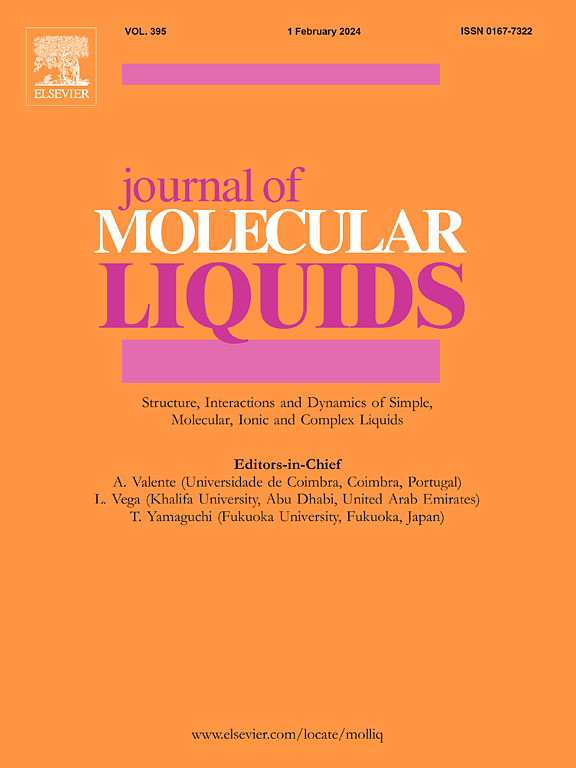Visible light promoted photocatalytic degradation of benzidine-based anionic diazo dye and its mechanistic studies using copper carbon dots incorporated biochar
IF 5.3
2区 化学
Q2 CHEMISTRY, PHYSICAL
引用次数: 0
Abstract
The increase in anthropogenic activities has an incremental effect on the contamination of water. Apart from all types of pollutants present in water, dyes contribute a major part to water pollution. In the current research, there is more emphasis on the synthesis of copper carbon dots doped biochar (Cu-CD-BC) and its application in the removal of benzidine-based anionic diazo dye i.e., Congo red (CR) dye from water samples under visible light irradiation in quick period. The novel copper doped carbon dots (Cu-CDs) prepared from the hydrothermal route were impregnated on the surface of biochar synthesized from pyrolytic carbonization to trigger the photocatalytic properties. The morphological structure and surface functionalities of the synthesized materials were characterized using HRTEM, UV, FESEM, XRD, and FTIR techniques. The Cu-CD-BC showed 99 % removal of CR dye at 20 mg L–1 in the shortest 12 mins of reaction time reported to date. Batch studies were conducted to evaluate the effect of different parameters like catalyst dosage, pH, contact time, and initial dye concentration. Radical trapping studies were conducted to determine the effect of radicals on the degradation activity. From the trapping experiments, it was evaluated that the ∙O2− and ∙OH radicals facilitate the degradation mechanism. To compare the effectiveness of the catalyst, we also conducted experiments using Cu-CDs, pristine biochar, and Cu-CD-BC for the removal studies. The findings indicated that the biochar and Cu-CDs showed poor photocatalytic properties which are enhanced when the Cu-CDs are impregnated on the surface of biochar. The mechanistic pathway was also framed based on trapping and GCMS results. Cycle studies were done to determine the efficiency and reusability of the catalyst.
可见光促进铜碳点生物炭光催化降解联苯胺基阴离子重氮染料及其机理研究
人为活动的增加对水的污染有逐渐增加的影响。除了水中存在的各种污染物外,染料是水污染的主要原因。目前的研究重点是铜碳点掺杂生物炭(Cu-CD-BC)的合成及其在可见光下快速脱除水样中以联苯胺为基础的阴离子重氮染料即刚果红(CR)染料的应用。将水热法制备的新型铜掺杂碳点(Cu-CDs)浸渍在热解碳化合成的生物炭表面,激发其光催化性能。利用HRTEM、UV、FESEM、XRD和FTIR等技术对合成材料的形态结构和表面功能进行了表征。Cu-CD-BC在20 mg L-1的浓度下,在迄今为止报道的最短12分钟的反应时间内,对CR染料的去除率达到99%。进行了批量研究,以评估催化剂用量、pH、接触时间和初始染料浓度等不同参数的影响。自由基捕获研究是为了确定自由基对降解活性的影响。通过诱捕实验,评价了∙O2−和∙OH自由基促进了降解机制。为了比较催化剂的效果,我们还进行了cu - cd、原始生物炭和Cu-CD-BC的去除实验。结果表明,生物炭和Cu-CDs的光催化性能较差,而Cu-CDs浸渍在生物炭表面后,其光催化性能得到增强。基于捕获和GCMS的结果,还构建了机制途径。进行了循环研究以确定催化剂的效率和可重复使用性。
本文章由计算机程序翻译,如有差异,请以英文原文为准。
求助全文
约1分钟内获得全文
求助全文
来源期刊

Journal of Molecular Liquids
化学-物理:原子、分子和化学物理
CiteScore
10.30
自引率
16.70%
发文量
2597
审稿时长
78 days
期刊介绍:
The journal includes papers in the following areas:
– Simple organic liquids and mixtures
– Ionic liquids
– Surfactant solutions (including micelles and vesicles) and liquid interfaces
– Colloidal solutions and nanoparticles
– Thermotropic and lyotropic liquid crystals
– Ferrofluids
– Water, aqueous solutions and other hydrogen-bonded liquids
– Lubricants, polymer solutions and melts
– Molten metals and salts
– Phase transitions and critical phenomena in liquids and confined fluids
– Self assembly in complex liquids.– Biomolecules in solution
The emphasis is on the molecular (or microscopic) understanding of particular liquids or liquid systems, especially concerning structure, dynamics and intermolecular forces. The experimental techniques used may include:
– Conventional spectroscopy (mid-IR and far-IR, Raman, NMR, etc.)
– Non-linear optics and time resolved spectroscopy (psec, fsec, asec, ISRS, etc.)
– Light scattering (Rayleigh, Brillouin, PCS, etc.)
– Dielectric relaxation
– X-ray and neutron scattering and diffraction.
Experimental studies, computer simulations (MD or MC) and analytical theory will be considered for publication; papers just reporting experimental results that do not contribute to the understanding of the fundamentals of molecular and ionic liquids will not be accepted. Only papers of a non-routine nature and advancing the field will be considered for publication.
 求助内容:
求助内容: 应助结果提醒方式:
应助结果提醒方式:


